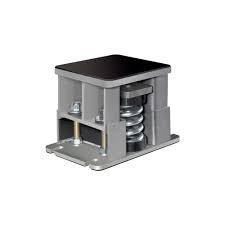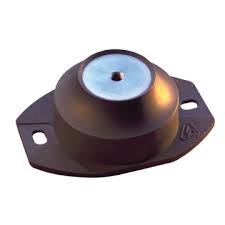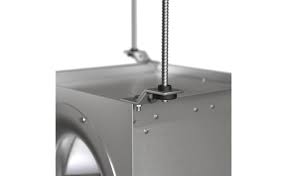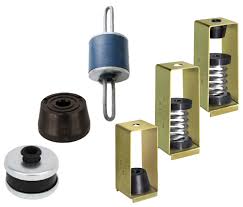Seismic base rubber vibration isolation mounts isolators are a crucial component in enhancing the safety of buildings in earthquake-prone areas. These isolators are designed to minimize the effects of seismic activity by decoupling the building structure from the ground motion. This innovative technology has been proven to reduce the risk of structural damage and collapse during earthquakes, ultimately saving lives and protecting valuable assets. In this article, we will explore the use of seismic base isolators in enhancing building safety, and the significant impact they have on mitigating the destructive forces of seismic events.
Seismic base isolators are devices that are used to protect buildings and structures from seismic activity by absorbing and dissipating the energy generated by ground motion. These isolators are typically installed between the foundation of a building and the ground, allowing the building to move independently of the ground motion during an earthquake. The use of seismic base isolators can significantly reduce the hanger mount vibration isolator impact of an earthquake on a building, helping to prevent structural damage and potential collapse. By allowing the building to move with the seismic waves, the isolators help to minimize the transfer of seismic energy into the structure, thereby enhancing its overall safety. In addition to protecting the building and its occupants, seismic base isolators can also help to minimize downtime and repair costs in the aftermath of an earthquake. By reducing the potential for structural damage, buildings equipped with these devices are more likely to remain operational following a seismic event, contributing to community resilience and continuity of essential services. Overall, the use of seismic base isolators represents an important strategy for enhancing building safety in seismic-prone areas, providing a valuable layer of protection against the destructive forces of earthquakes.
Seismic base isolators are devices that protect buildings from seismic activity by absorbing floor mount vibration isolator spring and dissipating ground motion energy. They are installed between a building's foundation and the ground, allowing the building to move independently during an earthquake. This significantly reduces the impact of seismic events, preventing structural damage and potential collapse. Seismic base isolators also minimize downtime and repair costs after an earthquake, as buildings equipped with these devices are more likely to remain operational. Overall, seismic base isolators are essential for enhancing building safety in seismic-prone areas and contribute to community resilience and continuity of essential services.
What Are Seismic Base Isolators and How Do They Work?

Seismic base isolators are essential components in the construction of buildings and structures located in earthquake-prone regions. These devices are designed to mitigate the impact of ground motion during seismic events by effectively isolating the structure from the shaking of the ground. By allowing the building to move independently from the ground, seismic base isolators help to minimize damage and protect the occupants inside. Their use has proven to be successful in enhancing the safety and resilience of buildings, making them an integral part of earthquake engineering and architecture.
Seismic base isolators are devices used to reduce the transmission of seismic forces from the ground to a structure during an earthquake. They work by allowing the building to move independently of the ground motion, effectively decoupling the structure from the shaking of the ground. Base isolators typically consist of a combination of flexible bearings, sliders, or rollers that are placed between the foundation of the building and the structure itself. When an earthquake occurs, the isolators absorb and dissipate the energy, allowing the building to move and sway with the seismic waves while reducing the forces transmitted to the superstructure. This technology has been widely used in the construction of critical infrastructure such as hospitals, bridges, and power plants, as well as in retrofitting existing buildings to improve their earthquake resistance. By incorporating seismic base isolators, buildings and other structures are better able to withstand the destructive forces of an earthquake, ultimately increasing their safety and resilience.
The Benefits of Using Seismic Base Isolators in Construction

Seismic base isolators are devices used in construction to protect buildings and other structures from the damaging effects of earthquakes. By incorporating these isolators into a building's foundation, engineers can reduce the amount of seismic energy that is transferred to the structure during an earthquake. This can help to prevent structural damage and ensure the safety of building occupants. One of the main benefits of using seismic base isolators is that they can significantly improve a building's resilience to seismic activity. By allowing the building to move independently of the ground motion, isolators help to dissipate the energy of an earthquake and limit the forces transmitted to the structure. This can result in reduced structural damage and downtime for repairs, ultimately saving time and money for building owners. In addition to improving resilience, seismic base isolators can also enhance the safety and comfort of building occupants during an earthquake. By minimizing the transfer of ground motion to the structure, isolators can help to reduce the amount of shaking and movement experienced within the building. This can help to prevent injury and panic among occupants, making for a safer and more secure environment. Furthermore, seismic base isolators can also contribute to the overall sustainability of a building. By reducing the potential for earthquake damage, isolators can help to extend the lifespan of a structure and minimize the need for costly repairs and replacements. This can ultimately reduce the environmental impact of a building and contribute to long-term sustainability. Overall, the use of seismic base isolators in construction can provide significant benefits in terms of resilience, safety, and sustainability. By incorporating these devices into building designs, engineers can help to mitigate the impact of earthquakes and ensure the long-term safety and functionality of structures.
Understanding the Role of Seismic Base Isolators in Earthquake Safety

Seismic base isolators are devices that are used to reduce the effects of an earthquake on a structure by decoupling it from the ground. This is achieved by allowing the building to move independently of the ground motion, thus reducing the forces transmitted to the structure during an earthquake. By doing so, seismic base isolators help to protect the building and its occupants from the damaging effects of seismic activity. These devices are commonly used in earthquake-prone areas to improve the safety and resilience of buildings and infrastructure.
Comparing Different Types of Seismic Base Isolators for Buildings

Seismic base isolators are devices installed between a building and its foundation to reduce the impact of seismic movements on the structure. There are several different types of seismic base isolators, including elastomeric, sliding, and friction pendulum isolators. Each type has its own advantages and disadvantages in terms of cost, effectiveness, and installation requirements. Elastomeric isolators are made of layers of rubber and steel, providing flexibility and damping characteristics to the building. They are relatively inexpensive and easy to install, making them a popular choice for many building projects. Sliding isolators use a combination of sliding bearings and curved surfaces to allow the building to move independently of the ground motion. They are effective at reducing seismic forces, but can be more costly and complex to install compared to elastomeric isolators. Friction pendulum isolators use a pendulum system to dissipate seismic energy, providing high levels of isolation and stability. However, they can be more expensive and require careful design and maintenance to ensure optimal performance. When comparing different types of seismic base isolators, it is important to consider factors such as building size, location, budget, and desired level of seismic protection. Consulting with a structural engineer or seismic isolation specialist can help determine the best type of isolator for a specific building project.
Case Studies: Successful Implementation of Seismic Base Isolators
Case studies have demonstrated the successful implementation of seismic base isolators in various buildings and structures. These isolators are designed to reduce the transfer of earthquake forces to a building, thereby minimizing damage and increasing safety. Successful case studies have shown that the use of seismic base isolators can effectively protect buildings and infrastructure during a seismic event. This technology has been implemented in a diverse range of structures including hospitals, bridges, and historical buildings, and has proven to be an effective method for mitigating earthquake damage.
The Future of Seismic Base Isolators in Architectural Design
seismic vibration isolators
Seismic base isolators are becoming increasingly relevant in architectural design as a means of protecting buildings from the destructive forces of earthquakes. These devices are placed between a building and its foundation, allowing the structure to move independently of the ground during seismic activity. This can significantly reduce the impact of the earthquake on the building and its occupants. In the future, seismic base isolators are expected to be integrated into a wider range of architectural designs, as awareness of their effectiveness grows. This is particularly true in areas prone to seismic activity, where the use of base isolators can be a crucial factor in ensuring the safety and resilience of buildings. Additionally, advancements in technology and materials are likely to lead to more innovative and cost-effective base isolator designs, further increasing their appeal to architects and developers. Overall, the future of seismic base isolators in architectural design looks promising, with their potential to enhance the safety and longevity of buildings in seismically active regions.
Important Considerations When Installing Seismic Base Isolators
When installing seismic base isolators, it is important to consider the weight and size of the structure being supported. The isolators need to be able to adequately support the load of the building while providing the necessary level of flexibility to absorb seismic energy. Additionally, the location and type of soil where the isolators will be installed is a crucial factor to consider. Different soil types have varying levels of stiffness and response to seismic activity, so the isolator system needs to be designed accordingly. The design and installation of seismic base isolators should also take into account the anticipated level of seismic activity in the region. Properly engineered isolators can help minimize the transfer of seismic energy to the structure, reducing potential damage. It is essential to work with experienced engineers and contractors who have expertise in the design and installation of seismic base isolator systems. Proper installation is critical to ensure that the isolators perform as intended during a seismic event. Regular maintenance and inspection of the isolator system is also important to ensure its continued effectiveness. It is important to follow the manufacturer's recommendations and guidelines for maintenance to keep the isolators in optimal condition.
Seismic Base Isolators: A Cost-Effective Solution for Earthquake-Prone Areas
Seismic base isolators are devices designed to protect structures from the damaging effects of earthquakes. They work by decoupling the building or structure from the ground, allowing it to move independently during an earthquake. This helps to reduce the forces transferred to the structure, minimizing damage and potential collapse. These isolators are a cost-effective solution for earthquake-prone areas because they can be installed relatively easily and are typically more affordable than other retrofitting or reinforcement methods. They also require minimal maintenance once installed, making them a practical long-term solution for earthquake preparedness. Seismic base isolators have been used in a variety of structures, including homes, bridges, and commercial buildings, and have proven to be effective in reducing the impact of seismic activity. As earthquakes continue to pose a significant threat to certain regions, the use of seismic base isolators is becoming increasingly popular as a reliable and cost-effective means of protecting structures and ensuring the safety of occupants.
In conclusion, seismic base isolators are a critical technology for enhancing building safety in earthquake-prone areas. By allowing buildings to absorb and dissipate seismic energy, these innovative devices can significantly reduce the risk of structural damage and collapse during earthquakes. Implementing seismic base isolators in construction projects is an essential step towards creating more resilient and secure buildings, ultimately safeguarding the lives and well-being of occupants.
See also
https://www.heliwigcarbon.com/products/vibration-isolators/